Chun-Ta Lu
Modeling Collaborator: Enabling Subjective Vision Classification With Minimal Human Effort via LLM Tool-Use
Mar 05, 2024Abstract:From content moderation to wildlife conservation, the number of applications that require models to recognize nuanced or subjective visual concepts is growing. Traditionally, developing classifiers for such concepts requires substantial manual effort measured in hours, days, or even months to identify and annotate data needed for training. Even with recently proposed Agile Modeling techniques, which enable rapid bootstrapping of image classifiers, users are still required to spend 30 minutes or more of monotonous, repetitive data labeling just to train a single classifier. Drawing on Fiske's Cognitive Miser theory, we propose a new framework that alleviates manual effort by replacing human labeling with natural language interactions, reducing the total effort required to define a concept by an order of magnitude: from labeling 2,000 images to only 100 plus some natural language interactions. Our framework leverages recent advances in foundation models, both large language models and vision-language models, to carve out the concept space through conversation and by automatically labeling training data points. Most importantly, our framework eliminates the need for crowd-sourced annotations. Moreover, our framework ultimately produces lightweight classification models that are deployable in cost-sensitive scenarios. Across 15 subjective concepts and across 2 public image classification datasets, our trained models outperform traditional Agile Modeling as well as state-of-the-art zero-shot classification models like ALIGN, CLIP, CuPL, and large visual question-answering models like PaLI-X.
Scaling Up LLM Reviews for Google Ads Content Moderation
Feb 07, 2024Abstract:Large language models (LLMs) are powerful tools for content moderation, but their inference costs and latency make them prohibitive for casual use on large datasets, such as the Google Ads repository. This study proposes a method for scaling up LLM reviews for content moderation in Google Ads. First, we use heuristics to select candidates via filtering and duplicate removal, and create clusters of ads for which we select one representative ad per cluster. We then use LLMs to review only the representative ads. Finally, we propagate the LLM decisions for the representative ads back to their clusters. This method reduces the number of reviews by more than 3 orders of magnitude while achieving a 2x recall compared to a baseline non-LLM model. The success of this approach is a strong function of the representations used in clustering and label propagation; we found that cross-modal similarity representations yield better results than uni-modal representations.
Visual Program Distillation: Distilling Tools and Programmatic Reasoning into Vision-Language Models
Dec 05, 2023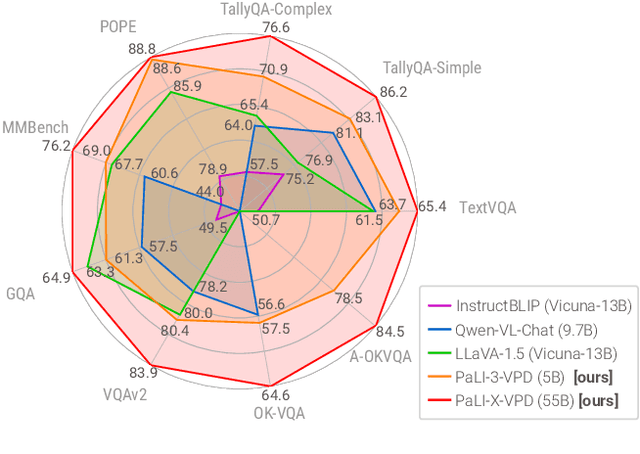
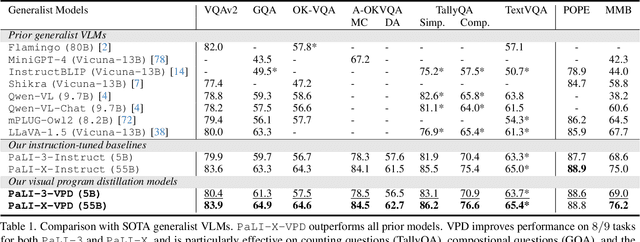
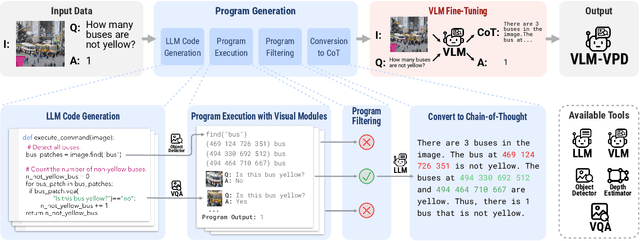
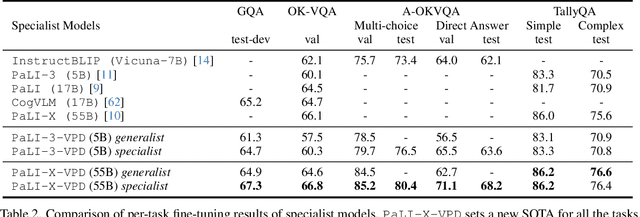
Abstract:Solving complex visual tasks such as "Who invented the musical instrument on the right?" involves a composition of skills: understanding space, recognizing instruments, and also retrieving prior knowledge. Recent work shows promise by decomposing such tasks using a large language model (LLM) into an executable program that invokes specialized vision models. However, generated programs are error-prone: they omit necessary steps, include spurious ones, and are unable to recover when the specialized models give incorrect outputs. Moreover, they require loading multiple models, incurring high latency and computation costs. We propose Visual Program Distillation (VPD), an instruction tuning framework that produces a vision-language model (VLM) capable of solving complex visual tasks with a single forward pass. VPD distills the reasoning ability of LLMs by using them to sample multiple candidate programs, which are then executed and verified to identify a correct one. It translates each correct program into a language description of the reasoning steps, which are then distilled into a VLM. Extensive experiments show that VPD improves the VLM's ability to count, understand spatial relations, and reason compositionally. Our VPD-trained PaLI-X outperforms all prior VLMs, achieving state-of-the-art performance across complex vision tasks, including MMBench, OK-VQA, A-OKVQA, TallyQA, POPE, and Hateful Memes. An evaluation with human annotators also confirms that VPD improves model response factuality and consistency. Finally, experiments on content moderation demonstrate that VPD is also helpful for adaptation to real-world applications with limited data.
Non-Intrusive Adaptation: Input-Centric Parameter-efficient Fine-Tuning for Versatile Multimodal Modeling
Oct 18, 2023



Abstract:Large language models (LLMs) and vision language models (VLMs) demonstrate excellent performance on a wide range of tasks by scaling up parameter counts from O(10^9) to O(10^{12}) levels and further beyond. These large scales make it impossible to adapt and deploy fully specialized models given a task of interest. Parameter-efficient fine-tuning (PEFT) emerges as a promising direction to tackle the adaptation and serving challenges for such large models. We categorize PEFT techniques into two types: intrusive and non-intrusive. Intrusive PEFT techniques directly change a model's internal architecture. Though more flexible, they introduce significant complexities for training and serving. Non-intrusive PEFT techniques leave the internal architecture unchanged and only adapt model-external parameters, such as embeddings for input. In this work, we describe AdaLink as a non-intrusive PEFT technique that achieves competitive performance compared to SoTA intrusive PEFT (LoRA) and full model fine-tuning (FT) on various tasks. We evaluate using both text-only and multimodal tasks, with experiments that account for both parameter-count scaling and training regime (with and without instruction tuning).
Agile Modeling: Image Classification with Domain Experts in the Loop
Feb 25, 2023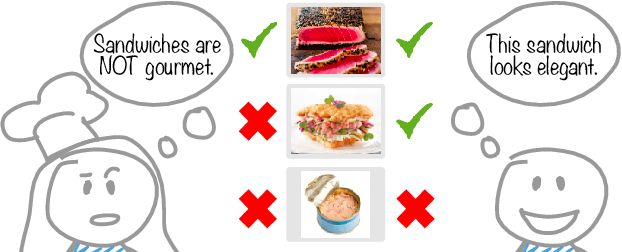


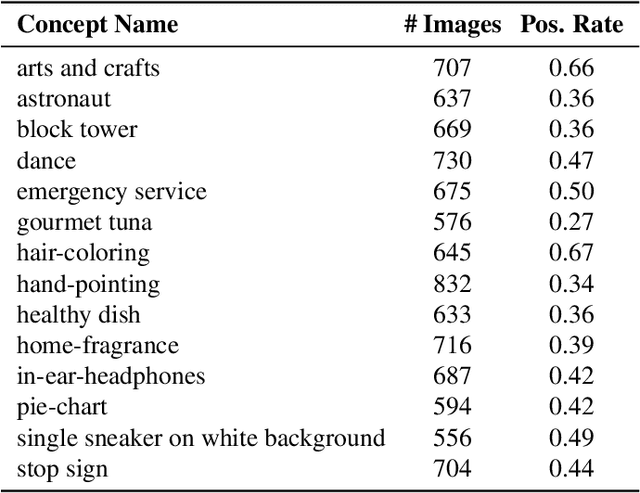
Abstract:Machine learning is not readily accessible to domain experts from many fields, blocked by issues ranging from data mining to model training. We argue that domain experts should be at the center of the modeling process, and we introduce the "Agile Modeling" problem: the process of turning any visual concept from an idea into a well-trained ML classifier through a human-in-the-loop interaction driven by the domain expert in a way that minimizes domain expert time. We propose a solution to the problem that enables domain experts to create classifiers in real-time and build upon recent advances in image-text co-embeddings such as CLIP or ALIGN to implement it. We show the feasibility of this solution through live experiments with 14 domain experts, each modeling their own concept. Finally, we compare a domain expert driven process with the traditional crowdsourcing paradigm and find that difficult concepts see pronounced improvements with domain experts.
Benchmarking Robustness to Adversarial Image Obfuscations
Jan 30, 2023



Abstract:Automated content filtering and moderation is an important tool that allows online platforms to build striving user communities that facilitate cooperation and prevent abuse. Unfortunately, resourceful actors try to bypass automated filters in a bid to post content that violate platform policies and codes of conduct. To reach this goal, these malicious actors may obfuscate policy violating images (e.g. overlay harmful images by carefully selected benign images or visual patterns) to prevent machine learning models from reaching the correct decision. In this paper, we invite researchers to tackle this specific issue and present a new image benchmark. This benchmark, based on ImageNet, simulates the type of obfuscations created by malicious actors. It goes beyond ImageNet-$\textrm{C}$ and ImageNet-$\bar{\textrm{C}}$ by proposing general, drastic, adversarial modifications that preserve the original content intent. It aims to tackle a more common adversarial threat than the one considered by $\ell_p$-norm bounded adversaries. We evaluate 33 pretrained models on the benchmark and train models with different augmentations, architectures and training methods on subsets of the obfuscations to measure generalization. We hope this benchmark will encourage researchers to test their models and methods and try to find new approaches that are more robust to these obfuscations.
CARLS: Cross-platform Asynchronous Representation Learning System
May 26, 2021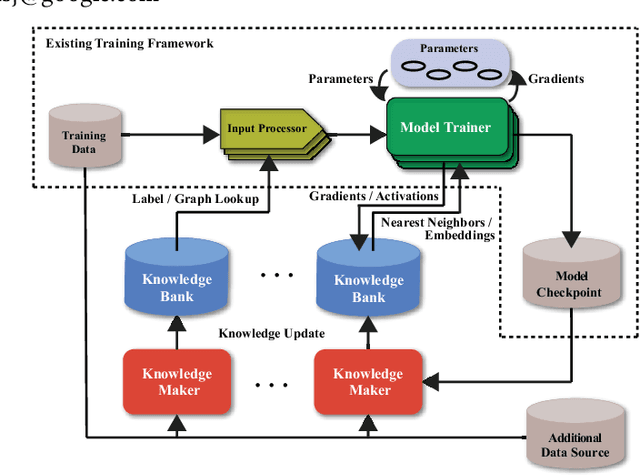

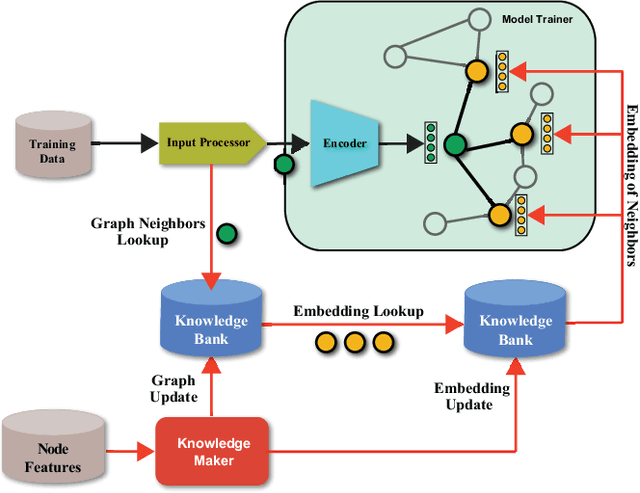
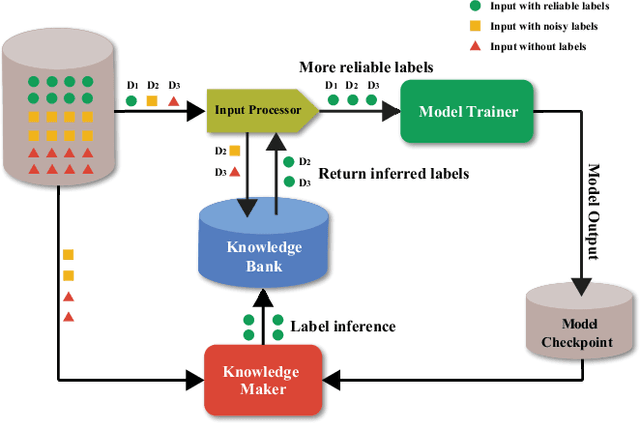
Abstract:In this work, we propose CARLS, a novel framework for augmenting the capacity of existing deep learning frameworks by enabling multiple components -- model trainers, knowledge makers and knowledge banks -- to concertedly work together in an asynchronous fashion across hardware platforms. The proposed CARLS is particularly suitable for learning paradigms where model training benefits from additional knowledge inferred or discovered during training, such as node embeddings for graph neural networks or reliable pseudo labels from model predictions. We also describe three learning paradigms -- semi-supervised learning, curriculum learning and multimodal learning -- as examples that can be scaled up efficiently by CARLS. One version of CARLS has been open-sourced and available for download at: https://github.com/tensorflow/neural-structured-learning/tree/master/research/carls
MZET: Memory Augmented Zero-Shot Fine-grained Named Entity Typing
Apr 02, 2020



Abstract:Named entity typing (NET) is a classification task of assigning an entity mention in the context with given semantic types. However, with the growing size and granularity of the entity types, rare researches in previous concern with newly emerged entity types. In this paper, we propose MZET, a novel memory augmented FNET (Fine-grained NET) model, to tackle the unseen types in a zero-shot manner. MZET incorporates character-level, word-level, and contextural-level information to learn the entity mention representation. Besides, MZET considers the semantic meaning and the hierarchical structure into the entity type representation. Finally, through the memory component which models the relationship between the entity mention and the entity type, MZET transfer the knowledge from seen entity types to the zero-shot ones. Extensive experiments on three public datasets show prominent performance obtained by MZET, which surpasses the state-of-the-art FNET neural network models with up to 7\% gain in Micro-F1 and Macro-F1 score.
Community-preserving Graph Convolutions for Structural and Functional Joint Embedding of Brain Networks
Nov 08, 2019



Abstract:Brain networks have received considerable attention given the critical significance for understanding human brain organization, for investigating neurological disorders and for clinical diagnostic applications. Structural brain network (e.g. DTI) and functional brain network (e.g. fMRI) are the primary networks of interest. Most existing works in brain network analysis focus on either structural or functional connectivity, which cannot leverage the complementary information from each other. Although multi-view learning methods have been proposed to learn from both networks (or views), these methods aim to reach a consensus among multiple views, and thus distinct intrinsic properties of each view may be ignored. How to jointly learn representations from structural and functional brain networks while preserving their inherent properties is a critical problem. In this paper, we propose a framework of Siamese community-preserving graph convolutional network (SCP-GCN) to learn the structural and functional joint embedding of brain networks. Specifically, we use graph convolutions to learn the structural and functional joint embedding, where the graph structure is defined with structural connectivity and node features are from the functional connectivity. Moreover, we propose to preserve the community structure of brain networks in the graph convolutions by considering the intra-community and inter-community properties in the learning process. Furthermore, we use Siamese architecture which models the pair-wise similarity learning to guide the learning process. To evaluate the proposed approach, we conduct extensive experiments on two real brain network datasets. The experimental results demonstrate the superior performance of the proposed approach in structural and functional joint embedding for neurological disorder analysis, indicating its promising value for clinical applications.
Graph-RISE: Graph-Regularized Image Semantic Embedding
Feb 14, 2019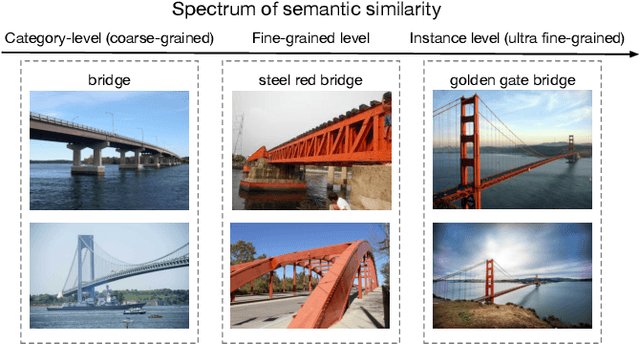
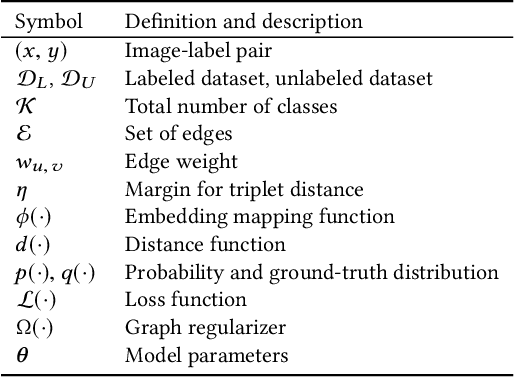
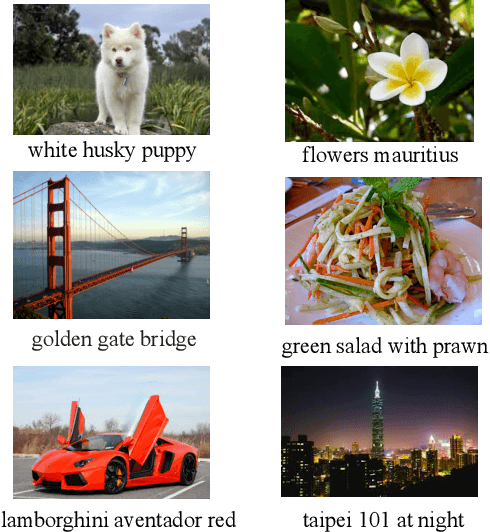
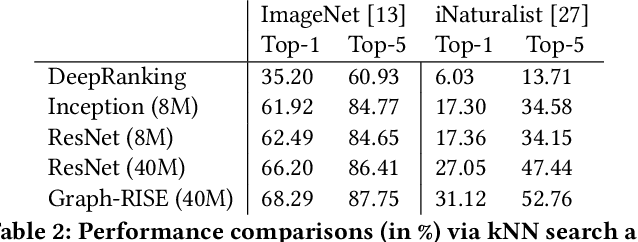
Abstract:Learning image representations to capture fine-grained semantics has been a challenging and important task enabling many applications such as image search and clustering. In this paper, we present Graph-Regularized Image Semantic Embedding (Graph-RISE), a large-scale neural graph learning framework that allows us to train embeddings to discriminate an unprecedented O(40M) ultra-fine-grained semantic labels. Graph-RISE outperforms state-of-the-art image embedding algorithms on several evaluation tasks, including image classification and triplet ranking. We provide case studies to demonstrate that, qualitatively, image retrieval based on Graph-RISE effectively captures semantics and, compared to the state-of-the-art, differentiates nuances at levels that are closer to human-perception.
 Add to Chrome
Add to Chrome Add to Firefox
Add to Firefox Add to Edge
Add to Edge